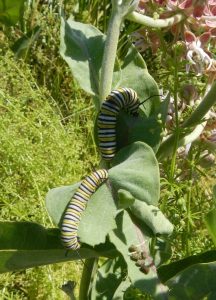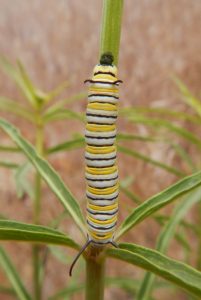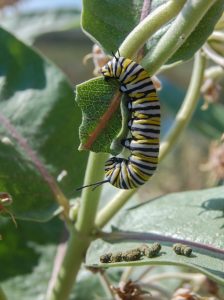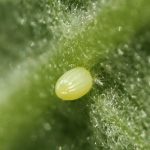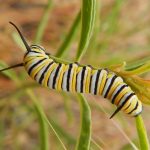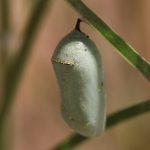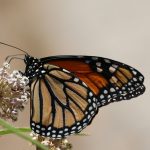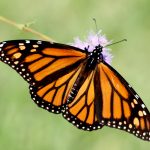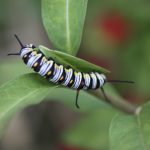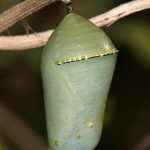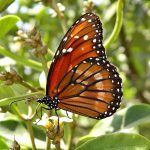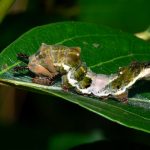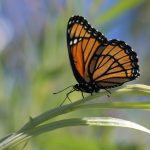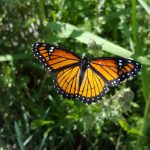Adult monarchs are the easiest life stage to find and identify, as they are large and showy and can be found flitting around milkweeds or other nectar plants. However, to determine whether milkweed patches are being used by breeding monarchs, we are most interested in observations of the immature stages of monarchs or of females actively ovipositing (laying eggs) on milkweeds.
Keying in to Monarch Clues
Immature life stages can be more difficult to find and identify than adult monarchs. If you are searching for monarchs when no adults are present, it is important to closely examine milkweed leaves and stems. Adult females usually lay eggs singly on the undersides of milkweed leaves near the top of the plant. However, they can also be deposited on the flower buds, stems, or lower leaves. Once a larva hatches, it immediately eats the eggshell and then begins feeding on the leaf. In many cases a single larva can defoliate an entire plant, sometimes even moving on to another plant before it forms a pupa. Keying in to signs of herbivory and the presence of frass (insect droppings, which typically appear as small, dry, usually dark-colored pellets on the leaves) can help you locate larvae. Look carefully at both sides of the leaves and the stems, and keep in mind that very young caterpillars may drop off the plant as a form of defense. Monarch caterpillars go through five instars, or stages between molts, during which they can range in size from 1/12″ –13/4″. First instar caterpillars are very small and may be pale green or grayish white, appearing almost translucent. Subsequent instars are distinctly striped in yellow, white, and black, with a pair of black tentacles on both ends of their bodies.
Monarch Mimics and Look-Alikes
Monarch adults, larvae, and pupae are fairly distinct, but you may also come across several closely related species or monarch mimics, including the queen butterfly (Danaus gilippus), soldier butterfly (Danaus eresimus), and the viceroy (Limenitis archippus). Both queens and soldiers also use milkweeds as host plants, but the larvae of the viceroy do not (and they look very different from monarch larvae!).
Monarch
Monarch adults have relatively dark black lines on the upper sides of their wings compared to queens and soldiers. Their caterpillars are distinct from those of queens and soldiers by having only two sets of antennae, rather than three.
- Monarch egg. (photo: Lisa Brown/flickr. CC BY-NC 2.0)
- Monarch caterpillar (photo: Stephanie McKnight/Xerces Society)
- Monarch pupa (photo: Stephanie McKnight/Xerces Society)
- Monarch adult (photo: Stephanie McKnight/Xerces Society)
- Monarch adult (photo: TexasEagle/flickr. CC BY-NC 2.0.)
Queen
Adults have fainter black lines on their wings than monarchs, are a darker orange color overall, and have white spots on their forewings. The caterpillars are somewhat similar to monarch caterpillars, but note the extra set of antennae halfway down the body (for a total of three pairs, opposed to the monarch’s two).
- Queen egg
- Queen caterpillar (photo: Adam Skowronski/flickr. CC BY-ND 2.0.)
- Queen pupa. Photo: Tom Murray/BugGuide. CC BY-ND-NC 1.0.
- Queen adult (photo: TexasEagle/flickr. CC BY-NC 2.0)
- Queen adult (photo: Texas Eagle/flickr. CC BY-NC 2.0)
Soldier
Similar to queen butterflies, soldier adults have fainter black lines on their wings than monarchs, are a darker orange color overall, and have white spots on their forewings.
- Soldier egg
- Soldier caterpillar
- Soldier pupa
- Soldier adult (photo: Bob Peterson/flickr. CC BY 2.0.)
- Soldier adult (photo: Alan Schmierer/flickr)
Viceroy
Note the distinct black lines that are perpendicular to the other black lines on the adult’s hindwings (it almost looks like a big smile has been drawn across its wings!). The caterpillars are very distinct and look nothing like monarch caterpillars. You likely won’t find them on milkweed, either.
- Viceroy egg
- Viceroy caterpillar (photo: Brad Smith/flickr. CC BY-NC 2.0.)
- Viceroy pupa
- Viceroy adult (photo: Stephanie McKnight/Xerces Society)
- Viceroy adult (photo: Stephanie McKnight/Xerces Society)

